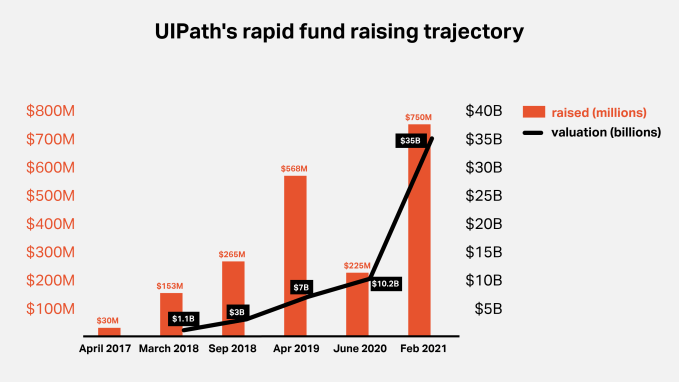Copenhagen-based process automation platform Leapwork has snagged Denmark’s largest ever Series B funding round, announcing a $62 million raise co-led by KKR and Salesforce Ventures, with existing investors DN Capital and Headline also participating.
Also today it’s disclosing that its post-money valuation now stands at $312M.
The ‘no code’ 2015-founded startup last raised back in 2019, when it snagged a $10M Series A. The business was bootstrapped through earlier years — with the founders putting in their own money, garnered from prior successful exits. Their follow on bet on ‘no code’ already looks to have paid off in spades: Since launching the platform in 2017, Leapwork has seen its customer base more than double year on year and it now has a roster of 300+ customers around the world paying it to speed up their routine business processes.
Software testing is a particular focus for the tools, which Leapwork pitches at enterprises’ quality assurance and test teams.
It claims that by using its ‘no code’ tech — a label for the trend which refers to software that’s designed to be accessible to non-technical staff, greatly increasing its utility and applicability — businesses can achieve a 10x faster time to market, 97% productivity gains, and a 90% reduction in application errors. So the wider pitch is that it can support enterprises to achieve faster digital transformations with only their existing mix of in-house skills.
Customers include the likes of PayPal, Mercedes-Benz and BNP Paribas.
Leapwork’s own business, meanwhile, has grown to a team of 170 people — working across nine offices throughout Europe, North America and Asia.
The Series B funding will be used to accelerate its global expansion, with the startup telling us it plans to expand the size of its local teams in key markets and open a series of tech hubs to support further product development.
Expanding in North America is a big priority now, with Leapwork noting it recently opened a New York office — where it plans to “significantly” increase headcount.
“In terms of our global presence, we want to ensure we are as close to our customers as possible, by continuing to build up local teams and expertise across each of our key markets, especially Europe and North America,” CEO and co-founder Christian Brink Frederiksen tells TechCrunch. “For example, we will build up more expertise and plan to really scale up the size of the team based out of our New York office over the next 12 months.
“Equally we have opened new offices across Europe, so we want to ensure our teams have the scope to work closely with customers. We also plan to invest heavily in the product and the technology that underpins it. For example, we’ll be doubling the size of our tech hubs in Copenhagen and India over the next 12 months.”
Product development set to be accelerated with the chunky Series B will focus on enhancements and functionality aimed at “breaking down the language barrier between humans and computers”, as Brink Frederiksen puts it
“Europe and the US are our two main markets. Half of our customers are US companies,” he also tells us, adding: “We are extremely popular among enterprise customers, especially those with complex compliance set-ups — 40% of our customers come from enterprises banking, insurance and financial services.
“Having said that, because our solution is no-code, it is heavily used across industries, including healthcare and life sciences, logistics and transportation, retail, manufacturing and more.”
Asked about competitors — given that the no code space has become a seething hotbed of activity over a number of years — Leapwork’s initial response is coy, trying the line that its business is a ‘truly special snowflake’. (“We truly believe we are the only solution that allows non-technical everyday business users to automate repetitive computer processes, without needing to understand how to code. Our no-code, visual language is what really sets us apart,” is how Brink Frederiksen actually phrases that.)
But on being pressed Leapwork names a raft of what it calls “legacy players” — such as Tricentis, Smartbear, Ranorex, MicroFocus, Eggplant Software, Mabl and Selenium — as (also) having “great products”, while continuing to claim they “speak to a different audience than we do”.
Certainly Leapwork’s Series B raise speaks loudly of how much value investors are seeing here.
Commenting in a statement, Patrick Devine, director at KKR, said: “Test automation has historically been very challenging at scale, and it has become a growing pain point as the pace of software development continues to accelerate. Leapwork’s primary mission since its founding has been to solve this problem, and it has impressively done so with its powerful no-code automation platform.”
“The team at Leapwork has done a fantastic job building a best-in-class corporate culture which has allowed them to continuously innovate, execute and push the boundaries of their automation platform,” added Stephen Shanley, managing director at KKR, in another statement.
In a third supporting statement, Nowi Kallen, principal at Salesforce Ventures, added: “Leapwork has tapped into a significant market opportunity with its no-code test automation software. With Christian and Claus [Rosenkrantz Topholt] at the helm and increased acceleration to digital adoption, we look forward to seeing Leapwork grow in the coming years and a successful partnership.”
The proof of the no code ‘pudding’ is in adoption and usage — getting non-developers to take to and stick with a new way of interfacing with and manipulating information. And so far, for Leapwork, the signs are looking good.
